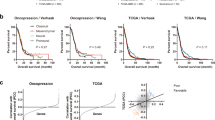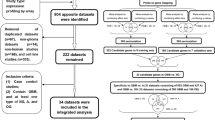Abstract
Malignant glioma is one of the most common primary brain tumors and is among the deadliest of human cancers. The molecular mechanism for human glioma is poorly understood. Early prognosis of this disease and early treatment are vital. Thus, it is crucial to target the key genes controlling pathogenesis in the early stage of glioma. In this study, differentially expressed genes in human glioma and paired peritumoral tissues were detected by transcriptome microarray analysis. Following gene microarray analysis, the gene expression profile in the differential grade glioma was further validated by bioinformatic analyses, co-expression network construction. Microarray analysis revealed that 1725 genes were differentially expressed and classified into different glioma stage. The analysis revealed 14 genes that were significantly associated with survival with a false discovery rate. Among these genes, macrophage capping protein (CAPG), a member of the actin-regulatory protein, was the key gene in a 20-gene network that modulates cell motility by interacting with the cytoskeleton. Furthermore, the prognostic impact of CAPG was validated by use of quantitative real-time polymerase chain reaction (qPCR) and immunohistochemistry on human glioma tissue. CAPG protein was significantly upregulated in clinical high-grade glioblastoma as compared with normal brain tissues. Overexpression of CAPG levels also predict shorter overall survival of glioma patients. These data demonstrated CAPG protein expression in human glioma was associated with tumorigenesis and may be a biomarker for identification of the pathological grade of glioma.





Similar content being viewed by others
References
Eckel-Passow JE, Lachance DH, Molinaro AM, Walsh KM, Decker PA, Sicotte H, et al. Glioma groups based on 1p/19q, IDH, and TERT promoter mutations in tumors. N Engl J Med. 2015;372:2499–508.
Turcan S, Rohle D, Goenka A, Walsh LA, Fang F, Yilmaz E, et al. IDH1 mutation is sufficient to establish the glioma hypermethylator phenotype. Nature. 2012;483:479–83.
Omuro A, DeAngelis LM. Glioblastoma and other malignant gliomas: a clinical review. JAMA. 2013;310:1842–50.
Bao ZS, Chen HM, Yang MY, Zhang CB, Yu K, Ye WL, et al. RNA-seq of 272 gliomas revealed a novel, recurrent PTPRZ1-MET fusion transcript in secondary glioblastomas. Genome Res. 2014;24:1765–73.
Lee K, Byun K, Hong W, Chuang HY, Pack CG, Bayarsaikhan E, et al. Proteome-wide discovery of mislocated proteins in cancer. Genome Res. 2013;23:1283–94.
Galadari S, Pallichankandy S, Rahman A, Thayyullathil F. ROS-dependent activation of autophagy is a critical mechanism for the induction of anti-glioma effect of sanguinarine. Free Radic Biol Med. 2015;89:708–20.
Renner G, Janouskova H, Noulet F, Koenig V, Guerin E, Bär S, Nuesch J, Rechenmacher F, Neubauer S, Kessler H, Blandin AF, Choulier L, Etienne-Selloum N, Lehmann M, Lelong-Rebel I, Martin S and Dontenwill M. Integrin α5β1 and p53 convergent pathways in the control of anti-apoptotic proteins PEA-15 and survivin in high-grade glioma. Cell Death Differ. 2015: doi: 10.1038/cdd.2015.131
Wei KC, Yeh WL, Lin HY, Huang CY, Huang BR, Lin C, et al. Migration-prone glioma cells show curcumin resistance associated with enhanced expression of miR-21 and invasion/anti-apoptosis-related proteins. Oncotarget. 2015;6(35):37770–81.
Wang Q, Zhang H, Zhang J, Wu C, Zhu W, Li F, Chen X and Xu B. The diagnostic performance of magnetic resonance spectroscopy in differentiating high-from low-grade gliomas: a systematic review and meta-analysis. Eur Radiol 2015; Epub ahead of print
Yuan S, Lu Y, Yang J, Chen G, Kim S, Feng L, et al. Metabolic activation of mitochondria in glioma stem cells promotes cancer development through a reactive oxygen species-mediated mechanism. Stem Cell Res Ther. 2015;6:198.
Zhang FY, Hu Y, Que ZY, Wang P, Liu YH, Wang ZH, et al. Shikonin inhibits the migration and invasion of human glioblastoma cells by targeting phosphorylated β-catenin and phosphorylated PI3K/Akt: a potential mechanism for the anti-glioma efficacy of a traditional Chinese herbal medicine. Int J Mol Sci. 2015;16:23823–48.
Gopinath S, Malla R, Alapati K, Gorantla B, Gujrati M, Dinh DH, et al. Cathepsin B and uPAR regulate self-renewal of glioma-initiating cells through GLI-regulated Sox2 and Bmi1 expression. Carcinogenesis. 2013;34:550–9.
Gupta P, Ghosh S, Nagarajan A, Mehta VS, Sen E. β-Defensin-3 negatively regulates TLR4-HMGB1 axis mediated HLA-G expression in IL-1β treated glioma cells. Cell Signal. 2013;25:682–9.
Kandavelu S, Vanisree AJ. A study on the biochemical and cytogenetic status in the blood of glioma patients. Pak J Biol Sci. 2011;14:511–8.
Zanotto-Filho A, Coradini K, Braganhol E, Schröder R, de Oliveira CM, Simões-Pires A, et al. Curcumin-loaded lipid-core nanocapsules as a strategy to improve pharmacological efficacy of curcumin in glioma treatment. Eur J Pharm Biopharm. 2013;83:156–67.
Kuijlen JM, Bremer E, Mooij JJ, den Dunnen WF, Helfrich W. Review: on TRAIL for malignant glioma therapy? Neuropathol Appl Neurobiol. 2010;36:168–82.
Raab P, Hattingen E, Franz K, Zanella FE, Lanfermann H. Cerebral gliomas: diffusional kurtosis imaging analysis of microstructural differences. Radiology. 2010;254:876–81.
Wei J, Wang F, Kong LY, Xu S, Doucette T, Ferguson SD, et al. miR-124 inhibits STAT3 signaling to enhance T cell-mediated immune clearance of glioma. Cancer Res. 2013;73:3913–26.
Gupta RA, Shah N, Wang KC, Kim J, Horlings HM, Wong DJ, et al. Long non-coding RNA HOTAIR reprograms chromatin state to promote cancer metastasis. Nature. 2010;464:1071–6.
Sun NX, Ye C, Zhao Q, Zhang Q, Xu C, Wang SB, et al. Long noncoding RNA-EBIC promotes tumor cell invasion by binding to EZH2 and repressing E-cadherin in cervical cancer. PLoS One. 2014;9:e100340.
Wang X, Zhang H, Wang D, Li X. Association of genetic polymorphisms of EGFR with glioma in a Chinese population. Genet Test Mol Biomarkers. 2015;19:59–62.
Jansen MH, Veldhuijzen van Zanten SE, Sanchez Aliaga E, Heymans MW, Warmuth-Metz M, Hargrave D, et al. Survival prediction model of children with diffuse intrinsic pontine glioma based on clinical and radiological criteria. Neuro-Oncology. 2015;17:160–6.
Sai K, Zhong MG, Wang J, Chen YS, Mou YG, Ke C, et al. Safety evaluation of high-dose BCNU-loaded biodegradable implants in Chinese patients with recurrent malignant gliomas. J Neurol Sci. 2014;343:60–5.
Vern-Gross TZ, Schreiber JE, Broniscer A, Wu S, Xiong X, Merchant TE. Prospective evaluation of local control and late effects of conformal radiation therapy in children, adolescents, and young adults with high-grade glioma. Neuro-Oncology. 2014;16:1652–60.
Antonopoulos M, Stamatakos G. In Silico Neuro-Oncology: Brownian Motion-Based Mathematical Treatment as a Potential Platform for Modeling the Infiltration of Glioma Cells into Normal Brain Tissue. Cancer Inform. 2015;14:33–40.
Dey M, Ulasov IV, Tyler MA, Sonabend AM, Lesniak MS. Cancer stem cells: the final frontier for glioma virotherapy. Stem Cell Rev. 2011;7:119–29.
Tate MC, Aghi MK. Biology of angiogenesis and invasion in glioma. Neurotherapeutics. 2009;6:447–57.
Fagin JA, Garcia-Rendueles ME, Ricarte-Filho JC, Untch BR, Landa I, Knauf JA, et al. NF2 loss promotes oncogenic RAS-induced thyroid cancers via YAP-dependent transactivation of RAS proteins and sensitizes them to MEK inhibition. Cancer Discov. 2015;5(11):1178–93.
Glaser J, Neumann MH, Mei Q, Betz B, Seier N, Beyer I, et al. Macrophage capping protein CapG is a putative oncogene involved in migration and invasiveness in ovarian carcinoma. Biomed Res Int. 2014;2014:379847.
Zhu WY, Hunag YY, Liu XG, He JY, Chen DD, Zeng F, et al. Prognostic evaluation of CapG, gelsolin, P-gp, GSTP1, and Topo-II proteins in non-small cell lung cancer. Anat Rec (Hoboken). 2012;295:208–14.
Acknowledgments
This study was supported by Health and Family Planning Commission research of Sichuan province (NO 150245).
Author information
Authors and Affiliations
Corresponding author
Ethics declarations
All patients and healthy controls agreed to genetic testing, as approved by the hospital institutional review board.
Conflicts of interest
None
Electronic supplementary material
Below is the link to the electronic supplementary material.
ESM 1
(DOC 3.83 mb)
Rights and permissions
About this article
Cite this article
Xing, W., Zeng, C. An integrated transcriptomic and computational analysis for biomarker identification in human glioma. Tumor Biol. 37, 7185–7192 (2016). https://doi.org/10.1007/s13277-015-4585-6
Received:
Accepted:
Published:
Issue Date:
DOI: https://doi.org/10.1007/s13277-015-4585-6




